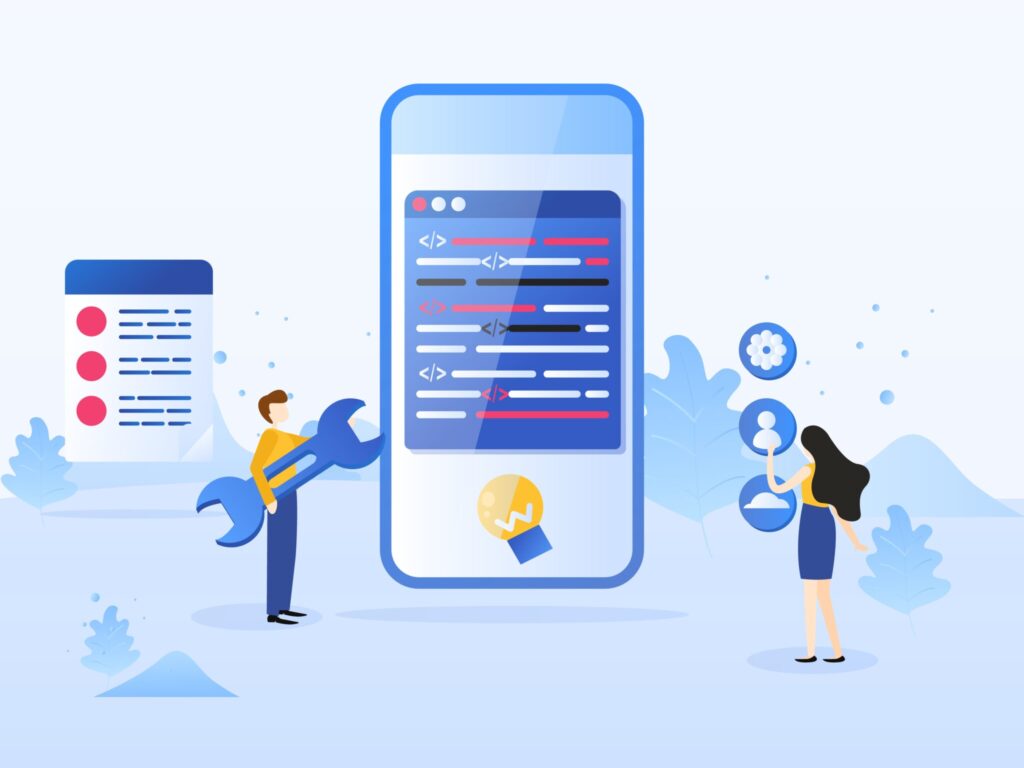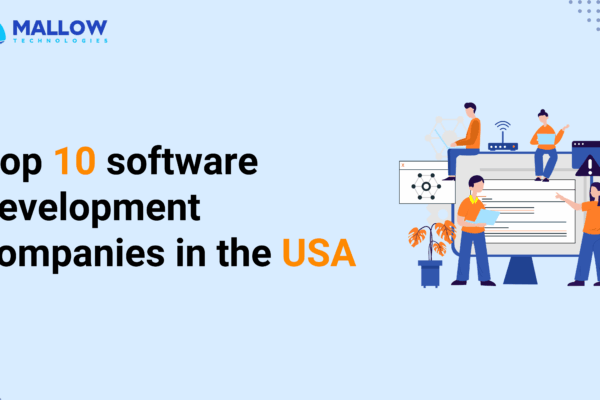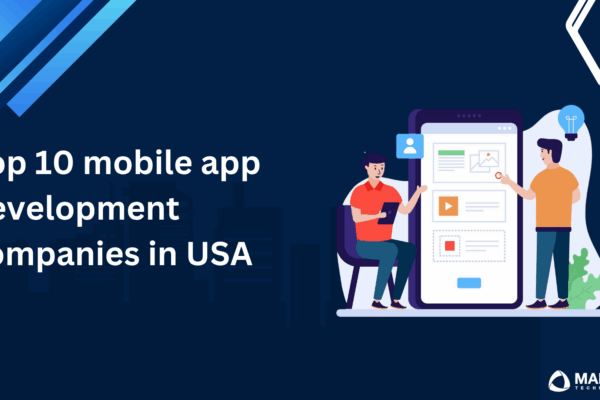When embarking on the journey of building a mobile application, diving in without a comprehensive understanding of the intricacies and potential costs can lead to unforeseen challenges. If you’ve found yourself in a quest for answers, you’re in the right place.
Developing a mobile application involves numerous components, including design, development, testing, and deployment. It’s crucial to gather the necessary insights and consider factors like the mobile application’s complexity, features, and target platforms, to ensure a well-informed and successful development journey. Whether you already own a mobile application or someone new to the world of mobile applications, navigating the mobile application development landscape requires careful planning and a clear roadmap to avoid pitfalls and create a remarkable mobile application.
Mallow has been instrumental in assisting a wide range of clients from various industries in making informed decisions when it comes to developing mobile application projects. We have consistently offered transparent cost assessments, enabling our clients to make sound choices for their businesses. This commitment to clarity and reliability is what continues to attract our clients back to us time and time again.
Upon completing this article, you will gain a comprehensive understanding of the approximate cost involved in the development of a mobile application. Furthermore, you will delve into detailed insights, offering a precise breakdown of the expenses associated with building a complete mobile application.
What factors affect the cost of mobile application development?
- The level of complexity of your mobile application – The complexity of your mobile application, including its features, functionalities, and user interactions, is a major factor. Simple mobile applications with basic features will cost less than complex mobile applications with advanced features and intricate UI/UX design. Depending on your mobile application’s requirements, you may need to use third-party plugins and libraries. While these can save development time, they may come with licensing fees or require customisations, impacting costs. If you require a high degree of customisation or scalability for future growth, development costs may increase.
- Backend Development – If your mobile application relies on a complex backend system or needs to integrate with external APIs and databases, development costs may rise due to the additional work required for backend development and API integration.
Here’s a table outlining factors to consider for backend development in mobile applications, along with examples of platforms, services, and tools.
| Purpose | Examples (Platforms/Services/Tools) |
| Server Hosting | AWS, Google Cloud Platform, Microsoft Azure, Heroku, DigitalOcean, etc. |
| Database | Firebase Realtime Database, Firebase Cloud Firestore, MySQL, PostgreSQL, MongoDB, etc. |
| Authentication & Authorisation | Firebase Authentication, Auth0, AWS Cognito, Keycloak |
| API Integration | RESTful APIs, GraphQL, gRPC, Third-party APIs (e.g., Google Maps, Twitter), Custom APIs |
| File Storage & CDN | Amazon S3 (Simple Storage Service), Google Cloud Storage, Azure Blob Storage, Firebase Cloud Storage, Cloudinary |
| Real-time Communication | WebSocket, Firebase Realtime Database (for chat apps), MQTT (Message Queuing Telemetry Transport), Pusher, Socket.io |
| Logging and Monitoring | Google Cloud Monitoring, Amazon CloudWatch, New Relic, Datadog |
| Scalability & Load Balancing | AWS Elastic Load Balancer, Google Cloud Load Balancing, NGINX Load Balancer, Kubernetes (for container orchestration) |
| Security | JWT (JSON Web Tokens), OAuth 2.0, SSL/TLS, Web Application Firewalls (WAFs), Security Headers (e.g., Content Security Policy) |
| Data Backup & Recovery | Regular Data Backups, Version Control (e.g., Git), Automated Disaster Recovery Plans, Data Replication |
Please make a note that these are key considerations and examples for various aspects of backend development in the context of a mobile application. Depending on your project’s specific requirements, you may choose different platforms, services, and tools to meet your backend needs.
- Design and UI/UX – A well-designed user interface (UI) and a seamless user experience (UX) are crucial for mobile application success. High-quality design work, animations, and user-centric features can increase development costs.
- Testing and quality assurance – Rigorous testing and quality assurance are essential to ensure your mobile application functions correctly and is free of bugs. The complexity of your mobile application and the extent of testing required can influence costs.
- Project management – Effective project management can help control costs by ensuring efficient use of resources and timely delivery. Poor project management can lead to delays and increased expenses. The development timeline affects costs. Rushed development may require more resources and could result in higher expenses. A longer timeline may also impact costs if the project extends beyond the initial estimates.
- Maintenance and updates – Consider the ongoing costs associated with maintaining and updating your mobile application post-launch. This includes bug fixes, feature enhancements, and platform updates.
- Legal and compliance requirements – Compliance with legal regulations, such as data protection (e.g., GDPR) or industry-specific standards, may necessitate additional development efforts and costs.
- Geographic location – The location of your development team or agency can influence costs. Development teams in regions with a lower cost of living may offer more competitive rates. The hourly rates of developers and development teams can vary widely based on location, expertise, and experience. More experienced developers or development agencies may charge higher rates.
How much does developing a mobile application cost?
One of the primary things to consider when looking at your options for getting the development work done is who will do the work. You have two main options: hiring an in-house team or using an outsourced team.
The cost of hiring in-house mobile application developers
In-house expertise involves establishing an in-house development team of mobile application experts who work directly for the company. This approach offers the advantage of having dedicated and full-time developers who are immersed in the company’s culture and objectives. It fosters greater control, real-time communication, and alignment between the development team and the organisation’s goals. In-house teams are often ideal for long-term projects or when ongoing development and maintenance are critical. However, this approach may incur higher initial costs due to salaries, benefits, and infrastructure requirements.

Here are some key factors to keep in mind:
- Proficiency in mobile development framework – Seek candidates with strong expertise in mobile development, emphasizing skills in Flutter, Dart programming, widget utilization, and mobile application state management. Evaluate their capabilities through a comprehensive portfolio review to gauge proficiency in mobile application development.
- Mobile development experience – Prior experience in mobile application development, whether for Android or iOS, is valuable. Candidates with a background in both native and cross-platform development can offer valuable insights.
- Programming proficiency – A strong grasp of programming fundamentals, including object-oriented programming (OOP) concepts, data structures, and algorithms, is crucial for building efficient and maintainable mobile applications.
- UI/UX design skills – For a well-rounded mobile application developer, consider those with design skills or an understanding of UI/UX principles. This can lead to more user-friendly and visually appealing mobile applications.
- Experience with state management – Assess candidates’ knowledge of state management solutions in mobile, such as Provider, Bloc, or Redux. Effective state management is essential for maintaining a responsive and organised mobile application.
- Cross-platform experience – If your project involves cross-platform development (iOS and Android), look for candidates with experience in developing and maintaining mobile applications on both platforms.
- Problem-Solving Abilities – Mobile application developers should be skilled at debugging, troubleshooting, and finding creative solutions to technical challenges that may arise during development.
- Collaboration Skills – Effective communication and teamwork are vital for developers working on complex projects. Ensure that candidates can work well with others and can articulate their ideas and solutions.
The cost of outsourcing mobile application development
On the other hand, outsourcing mobile application development involves hiring a third-party development agency or freelancers to build and maintain your mobile application. This approach offers flexibility in scaling the development team as needed, often reducing upfront costs as you only pay for the services rendered. Outsourcing can be particularly advantageous for short-term projects, MVP development, or when specific expertise is required. It also allows you to tap into a global talent pool, potentially accessing a broader range of skills.
Outsourcing may sometimes present challenges related to communication and time zone differences, as well as concerns about data security and quality control, which need to be carefully managed to ensure a successful partnership. Check out this article on how to hire a mobile application development team for more details on how you can handle the selection process of the mobile application development team efficiently.
Below is a simplified table outlining approximate cost ranges on how much it would cost for mobile applications of varied sizes when developed using different options like in-house or outsourcing:
| Mobile application Level | In-House Expertise (Approx. Cost) | Outsourcing (Approx. Cost) |
| Basic MVP | $50,000 – $150,000 | $20,000 – $40,000 |
| Medium-sized mobile application | $150,000 – $500,000 | $60,000 – $150,000 |
| Enterprise-level mobile application | $500,000 – $2,000,000+ | $200,000 – $1,000,000+ |
Please note that these cost estimates are approximate and can vary widely based on factors like the complexity of features, the size of the development team, geographical location, developer skill levels, project duration, and any additional services required (e.g., design, QA, ongoing maintenance).
What are the additional fixed costs of mobile application development?
- Server expenses – Server expenses can vary significantly based on your mobile application’s requirements. For small to medium-sized mobile applications, shared hosting or cloud-based services like AWS, Google Cloud, or Azure can cost between $100 to $500 per month. More extensive applications with high traffic and resource demands may require dedicated servers, which can range from $1000 to $5000+ per month or more.
- Mobile application deployment charges – Deployment charges are typically platform-specific. For Android, there’s a one-time fee of $25 to set up a Google Play Developer account. For iOS, you’ll need to enroll in the Apple Developer Program, which costs $99 per year. If you choose to publish your mobile application on both platforms, the combined cost would be $124 for the first year and $99 annually thereafter.
- Mobile application maintenance and updates – The cost of maintenance and updates can vary widely based on the complexity of your mobile application and the frequency of updates. On average, plan for around 15% to 20% of the initial development cost per year for ongoing maintenance. For example, if your mobile application development cost was $30,000, the annual maintenance cost might range from $4,500 to $6,000.
- Third-Party API integrations – Third-party API integration costs depend on the number and complexity of APIs you’re using. Many APIs offer a limited free tier with pricing that increases as you exceed usage limits. Costs can range from a few dollars per month for light usage to hundreds or thousands of dollars per month for high-volume mobile applications. For example, Google Map APIs might have a free tier with up to 2,500 requests per day, beyond which it could cost $0.50 to $2 per 1,000 additional requests.
Below is a table that will give a comprehensive analysis of how managing in-house expertise vs outsourcing your mobile application development weighs in terms of different criteria. This will give you a complete overview of which option to go with based on your requirements:
| Criteria | In-House Development | Outsourcing Development | Reason |
| Initial Setup Cost | High | Low | In-house setup requires infrastructure and hiring. Outsourcing leverages existing vendor resources. |
| Ongoing Development Costs | Medium | Low to Medium | In-house costs include salaries and benefits. Outsourcing provides cost predictability. |
| Talent and Expertise Availability | High | Dependent on service provider | In-house offers direct control over talent. Outsourcing relies on service provider’s expertise and the location they are based on. |
| Project Management Complexity | High | Lower | Outsourcing simplifies project management. In-house can be more complex. |
| Risk Management | Easier to Control | Shared with service provider | In-house provides more control over risk. Outsourcing shares risk with the service provider. |
| Quality Assurance and Testing | In-House | Service provider responsibility | In-house teams have direct control over QA. Outsourcing service providers handle QA. |
| Scalability | Limited | Easier to scale | Outsourcing offers scalability as needed. In-house may require hiring or layoffs. |
| Maintenance and Support | Managed by In-house | As provided by the service provider | In-house teams handle ongoing maintenance. Outsourcing includes post-development support. |
| Total Cost of Ownership (TCO) | High | Variable, depends on service provider | TCO for in-house is generally higher. Outsourcing costs vary by service provider. |
Please note that your specific situation and priorities will determine which criteria are most important for your organisation’s decision-making. You should assign weights to each criterion based on your priorities and use a scoring system to evaluate both options comprehensively.
How do mobile application development companies determine the cost they charge you?
Now that you have a comprehensive understanding of the elements involved in building a mobile application and the associated costs, a significant question emerges: Is the cost reasonable? To answer this question definitively, it’s essential to delve into the factors that mobile application development companies take into account when determining the fees they charge for their services.
For more details, check out this article on how mobile application development companies determine the cost they charge. This will allow you to explore the intricacies of how these companies arrive at their pricing decisions, providing valuable insights into the pricing mechanisms employed in the industry.
Still, feeling unsure about where you need to take your next step? Feel free to reach out to our team.
Your queries, our answers
Mobile application development involves creating software applications designed to run on mobile devices like smartphones and tablets. These apps can be native (built specifically for iOS or Android), cross-platform (designed to work on multiple platforms), or hybrid (combining elements of both).
Our mobile app development process includes the following stages: requirement gathering and analysis, design and prototyping, development and coding, testing and quality assurance, deployment, and post-launch support. Each stage is crucial to delivering a high-quality application.
To gain deeper insights into the experience of working on a mobile project with Mallow, explore more details here.
The choice between native and cross-platform development depends on your project’s goals, budget, and target audience. Native apps offer better performance and a more tailored user experience, while cross-platform apps allow for faster development and lower costs by using a single codebase for multiple platforms. For a detailed comparison of Native vs. Hybrid development, explore our comprehensive analysis to help you make an informed choice.
Mallow develops mobile apps for iOS, Android, and cross-platform solutions. We use the latest technologies and frameworks to ensure your app performs optimally on the platforms that matter most to your users.
Choosing the right features for your mobile app depends on understanding your target audience, business goals, and budget. We work closely with you to prioritize features that will provide the most value to your users and align with your business objectives.
At Mallow, we offer ongoing app maintenance and updates as part of our post-launch services. This includes regular updates to improve performance, add new features, and ensure compatibility with the latest operating systems. For more details, get in touch with our team.
Yes, Mallow assists with the entire app store submission process, including meeting the guidelines for Apple’s App Store and Google Play. We ensure your app is ready for submission and provide support to help it get approved.
Mallow uses a variety of technologies and frameworks for mobile app development, including Swift and Objective-C for iOS, Kotlin and Java for Android, and React Native and Flutter for cross-platform development. Our technology choices are driven by the specific needs of your project.
Our testing process includes functional testing, performance testing, security testing, usability testing, and compatibility testing across different devices and operating systems. We ensure your app is bug-free and performs optimally before it goes live.
The cost of developing a mobile app depends on several factors, including the app’s complexity, features, platform (iOS, Android, or both), and the development team’s expertise. Costs can range from $10,000 to $150,000 or more. To know more, check out how much it costs to work on a mobile project with us.
The development timeline for a mobile app varies depending on the complexity of the project. A basic app may take 2-4 months to develop, while a more complex app with advanced features can take 6-12 months or longer.
Choosing the right features for your mobile app depends on understanding your target audience, business goals, and budget. We work closely with you to prioritize features that will provide the most value to your users and align with your business objectives.
Yes, Mallow offers comprehensive post-launch support, including monitoring, updates, bug fixes, and enhancements. We ensure your app remains up-to-date and continues to perform well after it’s launched.
A mobile app can enhance customer engagement, increase brand visibility, provide better service through personalized experiences, and create new revenue streams. It also allows you to reach a broader audience by making your services more accessible on mobile devices.
Getting started with Mallow is easy! Simply reach out to us to discuss your project. We’ll work with you to understand your goals, define your requirements, and create a development plan that meets your needs. Let’s bring your mobile app idea to life!.
Security is a top priority at Mallow. We implement advanced security measures, including encryption, secure authentication, and regular security audits, to protect your app from potential threats and ensure data integrity.
To learn more about how we handle and implement these security measures, check out more details here.
Author
SathishPrabhu
Sathish is an accomplished Project Manager at Mallow, leveraging his exceptional business analysis skills to drive success. With over 8 years of experience in the field, he brings a wealth of expertise to his role, consistently delivering outstanding results. Known for his meticulous attention to detail and strategic thinking, Sathish has successfully spearheaded numerous projects, ensuring timely completion and exceeding client expectations. Outside of work, he cherishes his time with family, often seen embarking on exciting travels together.



